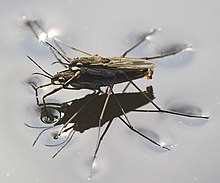| Heteroptera Temporal range:
| |
|---|---|

| |
| Two water striders mating | |
| Scientific classification | |
| Domain: | Eukaryota |
| Kingdom: | Animalia |
| Phylum: | Arthropoda |
| Class: | Insecta |
| Order: | Hemiptera |
| Suborder: | Heteroptera Latreille, 1810 |
| Infraorders | |
The Heteroptera are a group of about 40,000 species of insects in the order Hemiptera. They are sometimes called "true bugs",[1] though that name more commonly refers to the Hemiptera as a whole. "Typical bugs" might be used as a more unequivocal alternative, since the heteropterans are most consistently and universally termed "bugs" among the Hemiptera. "Heteroptera" is Greek for "different wings": most species have forewings with both membranous and hardened portions (called hemelytra); members of the primitive sub-group Enicocephalomorpha have completely membranous wings.
The name "Heteroptera" is used in two very different ways in modern classifications. In Linnean nomenclature, it commonly appears as a suborder within the order Hemiptera, where it can be paraphyletic or monophyletic depending on its delimitation. In phylogenetic nomenclature, it is used as an unranked clade within the Prosorrhyncha clade, which in turn is in the Hemiptera clade. This results from the realization that the Coleorrhyncha are just "living fossil" relatives of the traditional Heteroptera, close enough to them to be united with that group.
The infraorders Leptopodomorpha, Gerromorpha, and Nepomorpha, comprise a significant component of the world's aquatic and semiaquatic insects. There are 23 families, 343 genera and 4,810 species group taxa within these three infraorders.[2] Most of the remaining groups that are common and familiar are in the Cimicomorpha and Pentatomomorpha.
- ^ Tree of Life Web Project (2005): Heteroptera. True bugs. Version of January 1, 2005. Retrieved July 28, 2008.
- ^ Polhemus, John T.; Polhemus, Dan A. (2008). "Global diversity of true bugs (Heteroptera; Insecta) in freshwater". Hydrobiologia. 595 (5): 379–91. doi:10.1007/s10750-007-9033-1. S2CID 45657091.